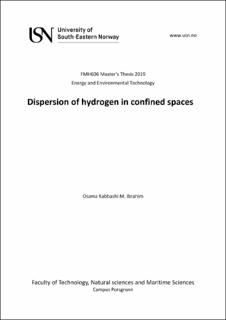| dc.description.abstract | Usage of hydrogen as fuel gives rise to possible accidental risks due to leakage and
dispersion. The highest risk from hydrogen leak is the formation of a large volume of the
hydrogen-air mixture, which could be ignited leading up to a severe explosion. Prevention
and control of formation and ignition of hydrogen combustible cloud necessitate sufficient
knowledge of mechanisms of the hydrogen leak, dispersion, and over-pressures generated
during ignition and explosion.
This study aims to investigate the momentum-controlled jet, the buoyancy-controlled
wave and the parameters influence hydrogen concentration distribution in confined
spaces. It demonstrates experimental results and analysis from helium and hydrogen
dispersion and explosion in a channel. two groups of experiments were carried out. Firstly,
a set of experiments for the release of helium and hydrogen jets in a 3 m long channel to
record their concentrations in the cloud by concentration sensors at different horizontal
and vertical positions. Secondly, a series of hydrogen explosionsin the channel to examine
the overpressures built-up during the combustion process and the flame propagation
characteristics. Two flow visualization techniques were applied by means of Backgroundoriented Schlieren and Shadowgraph along with high-speed video camera to image the
mixing process around the release point, the helium-, hydrogen-air cloud shape at the
middle of the channel and flame evolution after ignition of hydrogen-air mixture cloud.
Moreover, results were used for comparison of helium and hydrogen concentration
gradients.
Experiments results show swift mixing occurs at higher flow rates, smaller nozzle sizes,
and downward release direction. Higher concentration recorded in the channel with
negative inclination. Results also confirmed that hydrogen/ helium behavior pattern in the
channel accords with mutual intrusion theory about gravity currents. On the question of
an explosion of the hydrogen-air mixture in a channel, this study found that for short
release time of hydrogen, the highest overpressure was generated when the flame passed
through the mixing zone around the jet. For a long time release, the highest overpressure
generated after the ignition in the proximity of ignition source. This could be a realistic
scenario when hydrogen accumulates after accidental leakage in a tunnel or channel and
subsequent ignition of the hydrogen-air cloud. | en_US |
